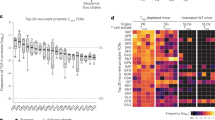Abstract
T-cell lines established from individuals infected with human T-cell leukaemia virus (HTLV) or generated by co-cultivation of normal human T cells with HTLV-infected T-cells, express class II (HLA-D/DR or Ia) antigens of the major histocompatibility complex (MHC)1 and interleukin-2 (IL-2) receptors2. Because the expression of these markers characterizes the differentiation of immunologically activated T cells3, we have now explored the possibility that HTLV- infected T cells might be primed to autologous or allogeneic Ia antigens expressed by the infecting cells. Our studies on the capacity of HTLV-infected T cells to display responses on mixed lymphocyte culture indicate that such T cells as well as single-cell clones derived from them, react non-discriminatively to all known allelic variants of human HLA-D/DR antigens, including those expressed by the responding cells. This reaction is inhibited by antibody to human Ia and is not triggered by Ia-negative T-leukaemia cells. The structure recognized seems to be a common epitope determinant of human Ia antigens, as (HTLV-infected) T cells primed in vitro to one HLA-D/DR specificity display amplified responses to all other HLA-D/DR antigens. We therefore believe that autostimulation by a self-Ia determinant may trigger the clonal expansion of HTLV-infected T cells and potentiate autoimmune processes.
This is a preview of subscription content, access via your institution
Access options
Subscribe to this journal
Receive 51 print issues and online access
$199.00 per year
only $3.90 per issue
Buy this article
- Purchase on Springer Link
- Instant access to full article PDF
Prices may be subject to local taxes which are calculated during checkout
Similar content being viewed by others
References
Gallo, R. C. et al. Proc. natn. Acad. Sci. U.S.A. 79, 5680–5683 (1982).
Popovic, M. et al. Proc. natn. Acad. Sci. U.S.A. 80, 5402–5406 (1983).
Suciu-Foca, N. et al. Transplantation 10, 845–848 (1978).
Poiesz, B. J. et al. Proc. natn. Acad. Sci. U.S.A. 77, 7415–7419 (1980).
Zoschke, D. & Bach, F. H. J. Immun. Meth. 1, 55–65 (1971).
Suciu-Foca, N. et al. J. exp. Med. 156, 283–287 (1982).
Reinherz, E. L. et al. Immun. Rev. 74, 83–112 (1983).
Author information
Authors and Affiliations
Rights and permissions
About this article
Cite this article
Suciu-Foca, N., Rubinstein, P., Popovic, M. et al. Reactivity of HTLV-transformed human T-cell lines to MHC class II antigens. Nature 312, 275–277 (1984). https://doi.org/10.1038/312275a0
Received:
Accepted:
Issue Date:
DOI: https://doi.org/10.1038/312275a0
This article is cited by
-
Immunohistochemical and ultrastructural studies of thyroid tissue from a patient with Basedow's disease and immunopositive for human T-lymphotropic virus type I (HTLV-I)
Medical Electron Microscopy (1994)
-
Modulation of the cell-mediated immune function by interferon α, β or γ can partially reverse the immunosuppression induced by human T-cell leukemia virus I in human cord blood cultures
Cancer Immunology Immunotherapy (1990)
-
HTLV: The family of human T-lymphotropic retroviruses and their role in leukemia and AIDS
Medical Oncology and Tumor Pharmacotherapy (1986)
-
Human T-lymphotropic retroviruses
Nature (1985)
-
A late-differentiation antigen associated with the helper inducer function of human T cells
Nature (1985)
Comments
By submitting a comment you agree to abide by our Terms and Community Guidelines. If you find something abusive or that does not comply with our terms or guidelines please flag it as inappropriate.



